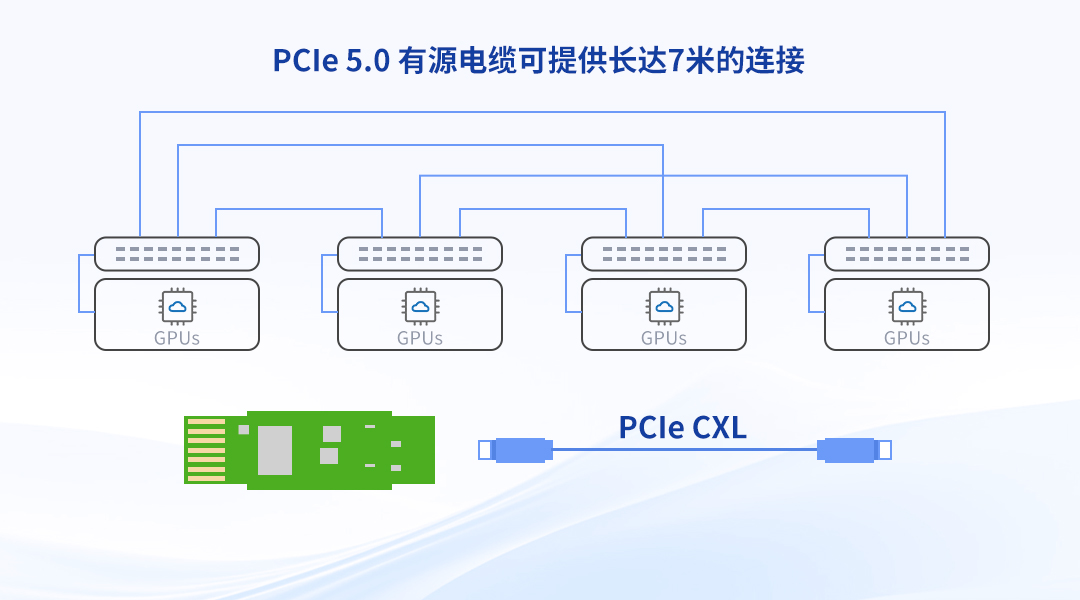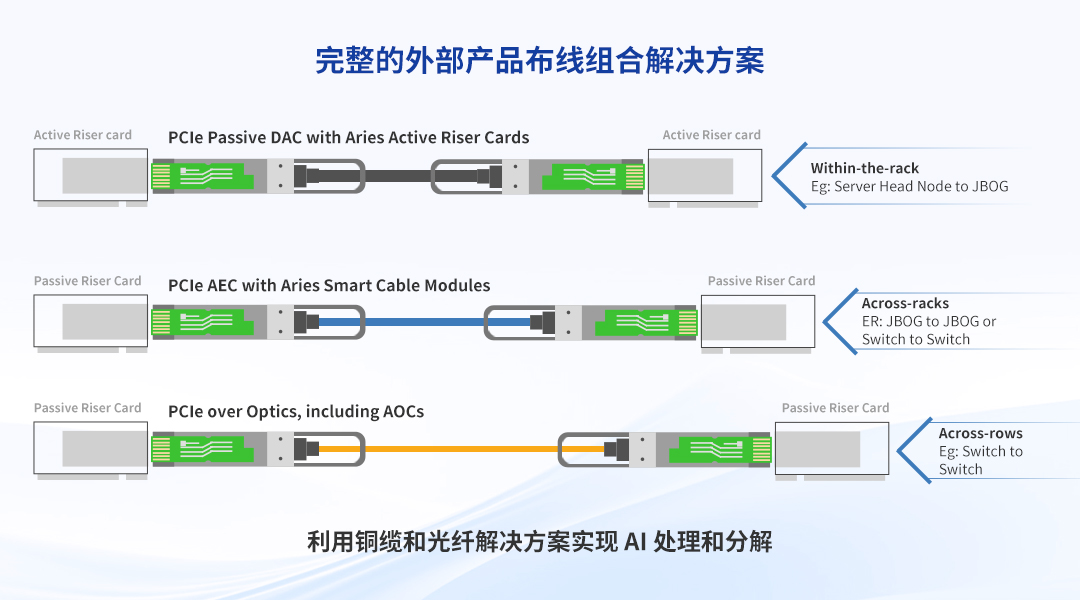
PCIe через оптику: начало новой эры соединений и транспорта искусственного интеллекта
С бумом генеративных технологий искусственного интеллекта мы вступаем в новую эру, где все хранится, все умно и все взаимосвязано. В эту эпоху поток данных нарастает как приливная волна, создавая беспрецедентные проблемы для инфраструктуры центров обработки данных. Чтобы удовлетворить растущие вычислительные потребности моделей ИИ, модели большого языка (LLM) должны одновременно обрабатывать огромные мультимодальные наборы данных, включая текст, изображения, аудио и видео, что привело к резкому росту спроса на ресурсы обработки ИИ и требует эффективных взаимосвязей между дата-центр.
Перед лицом этой проблемы традиционные соединения данных с трудом справляются с потребностями масштабирования современных кластеров ИИ. Благодаря диверсификации и настройке архитектур платформ искусственного интеллекта, а также значительному ускорению темпов ежегодных обновлений центры обработки данных должны найти более эффективные и надежные решения для подключения. На этом фоне появилась технология «PCIe поверх оптики», предлагающая новые возможности для расширения и модернизации инфраструктуры искусственного интеллекта.
Интерфейс PCIe (Peripheral Component Interconnect Express), который изначально доступен на педалях газа AI и графических процессорах, всегда играл важную роль в соединении различных компонентов в центре обработки данных. Однако по мере того, как кластеры искусственного интеллекта продолжают расти в размерах: от нескольких стоек и десятков графических процессоров до крупных модулей, охватывающих более нескольких стоек и сотен графических процессоров, длина межсоединений быстро становится ключевым ограничением производительности. Хотя активные кабели способны покрывать расстояния до 7 метров при скорости передачи данных PCIe 5.0, при более высоких скоростях передачи данных, таких как PCIe 6.x и PCIe 7.x, традиционные медные решения больше не могут удовлетворить спрос на межстоечные соединения.

Ответ на вызов соединения AI
С 2017 года Astera Labs стремится раскрыть потенциал искусственного интеллекта и облачных инфраструктур с помощью своей интеллектуальной платформы подключения, которая создает масштабируемые, настраиваемые архитектуры на основе полупроводниковых решений PCIe®, CXL® и Ethernet, а также программного пакета COSMOS.
Платформа обеспечивает надежную связь на больших расстояниях, ускоряя развертывание кластеров графических процессоров сегодня благодаря оптике, обеспечивающей соединение PCIe-to-line; сокращение времени развертывания платформы искусственного интеллекта за счет программно-определяемой архитектуры и тестирования совместимости; и улучшение времени безотказной работы и использования инфраструктуры с помощью таких функций, как глубокая диагностика.
Широкий ассортимент продукции включает в себя ретаймер Aries®PCIe®/CXL® Smart DSP с высокой пропускной способностью и широким спектром приложений, интеллектуальный кабельный модуль Aries PCIe/CXL (SCM), который предоставляет 7-метровые активные кабели для подключения к стойке, Интеллектуальный кабельный модуль Taurus Ethernet (SCM), поддерживающий высокоскоростное соединение Ethernet, и интеллектуальный контроллер памяти Leo CXL®, оптимизирующий управление памятью. Astera Labs выделяется в области технологических инноваций, закладывая основу для широкомасштабного внедрения передовых решений.
Начинаем новую главу в области бесперебойного взаимодействия с искусственным интеллектом
По мере масштабирования инфраструктуры искусственного интеллекта традиционные пассивные кабели прямого подключения (DAC) с трудом справляются со спросом. Проблемы потери сигнала усугубляются при высоких скоростях передачи данных, что ограничивает эффективность пассивных решений. В ответ на это были созданы активные кабели Aries PCIe/CXL® SCM™ (AEC) с 7-метровым покрытием, чтобы устранить ограничения по расстоянию подключения ЦАП, предоставляя больше возможностей для расширения кластера педали газа AI с кабелями, которые можно легко удлинить за пределы стойка. Однако по мере увеличения скорости передачи данных до более высоких уровней, таких как PCIe 6.x и 7.x, пассивные и активные кабели будут ограничены одной стойкой. На этом этапе решения PCIe по оптике, особенно активные оптические кабели (AOC), будут играть ключевую роль в соединении между стойками, обеспечивая высокостабильное соединение на большие расстояния и гарантируя эффективную работу кластеров искусственного интеллекта.

Изучение будущего оптических соединений PCIe
Оптоволоконные каналы стали краеугольным камнем высокоскоростного подключения Ethernet, поддерживая передачу данных на большие расстояния в гипермасштабных центрах обработки данных. Включение этого преимущества в возможности подключения PCIe путем разработки новых решений PCIe по оптике (с AOC) значительно расширяет диапазон возможностей подключения PCIe к стоечным кластерам и оптимизирует прокладку кабелей по сравнению с медными кабелями.

Использование PCIe/CXL® в оптике обусловлено необходимостью более низкой задержки по сравнению с Ethernet, особенно в приложениях с высокой нагрузкой, таких как транзакции с когерентной кэш-памятью и параллельная обработка между графическими процессорами. Кроме того, эти приложения требуют специального программного обеспечения для полного управления каналом, чтобы обеспечить полную совместимость протоколов и высокую надежность системы.
Короче говоря, появление технологии «PCIe поверх оптики» обеспечивает новое решение для передачи данных внутри центра обработки данных. Это не только повышает эффективность и стабильность передачи данных, но также снижает затраты на эксплуатацию и обслуживание, обеспечивая надежную поддержку ускоренного развертывания платформ искусственного интеллекта и быстрой разработки генеративных приложений искусственного интеллекта следующего поколения. Ожидается, что благодаря постоянному развитию технологий и расширению сценариев применения «PCIe поверх оптики» станет одной из основных технологий в области хранения и передачи данных в будущем.
Категории
Новый блог
Теги
новые продукты
Оптический трансивер 1.25G SFP 1550 нм 200 км LC Читать далее
Оптический трансивер 10G SFP+ ZR 1550 нм 120 км LC Читать далее
100G QSFP28 ZR4 BIDI 80 км оптическое трансивер Читать далее
Оптический приемопередатчик 100G QSFP28 LR с одинарной лямбдой 10 км LC Читать далее
Оптический приемопередатчик 25G SFP28 ZR 1310 нм 80 км LC Читать далее
Оптический приемопередатчик 100G QSFP28 ZR4 80KM LC поколения II Читать далее
Оптический приемопередатчик 100G QSFP28 BIDI 40 км LC Читать далее
Оптический приемопередатчик 100G QSFP28 BIDI 10 км LC Читать далее
© Авторские права: 2025 ETU-Link Technology CO ., LTD Все права защищены.

Поддерживается сеть IPv6